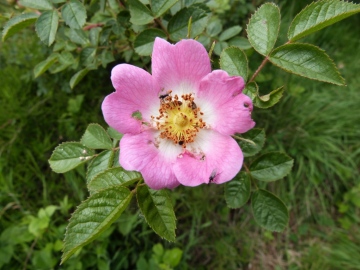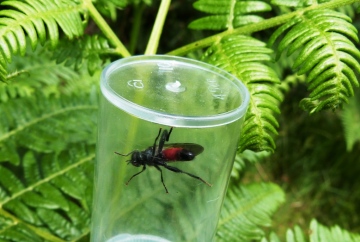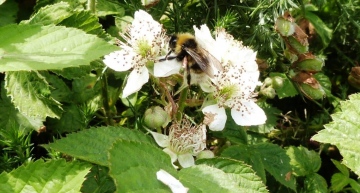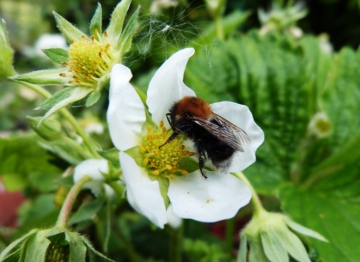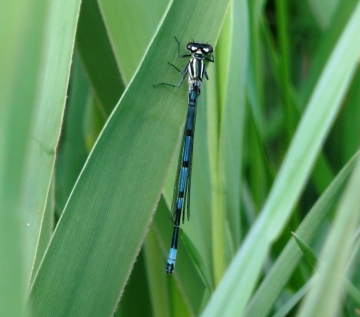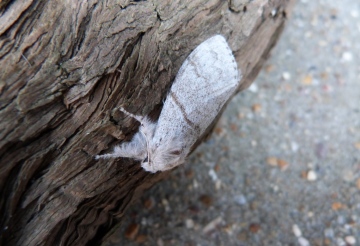Your Forum
The weblog below is for naturalists to use to report interesting sightings, ask questions, report on field meetings and generally post pictures and any information or questions generally relevant in some way to the wildlife and geology of Essex. You will need to register and be logged-on to post to the forum, and you need to upload pictures first, for use in posts. Find out more
|
Sun 30th June 2013 17:48 by Mary Smith almost July...
... and I have just eaten our first two ripe raspberries. They are usually pretty near past it at the end of June, but this year is still about 4 weeks behind. Similarly, in the front garden, we have wild strawberries(throwbacks from cultivation actually), which are also late.
Then I spotted a plant I did not recognise. It had slender leaves in one plane like an Iris, with two wilting blue flowers at the top of the thin stem. The flowers were drooping with 6 similar tepals, more star-like than anything like an Iris. The plant seems to be Sisyrinchium montanum, American Blue-eyed-grass, clearly a garden escape, but where from I have no idea.
Life is full of surprises! Sat 29th June 2013 19:51 by Peter Pearson Continental Invader
Last week my wife and I decide to take a short break over the water, in Whitstable. It was to be a rest and I didn’t take the net or pots etc, just the camera.
On the way down we called in to Faversham the home of several Thames Barges, another passion of mine. Unfortunately they had made their summer migration so there were only two right at the far end of the quay.
To reach them I had to walk through a narrow footpath bordered by thick vegetation. On the way through I spotted the below insect. 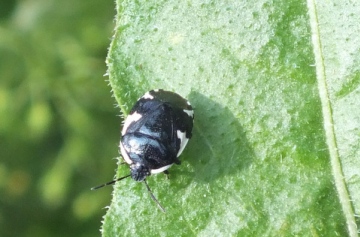 Placed on i-Spot it was identified as a Rambur’s Pied Shieldbug Tritomegas sexmaculatus apparently this Shieldbug was first found in Kent in 2011 and has since been identified in four sites, and thought to colonising. Thought this observation may be of interest as I am not aware of it’s arrival in Essex, but Faversham is literally a stones throw away and if it hasn’t been found yet it is a possibility soon. Fri 28th June 2013 16:04 by Graham Smith Travels around a bramble bush
Mark Hanson, former EFC President, came here on a visit last Wednesday (26th) and we walked to Mill Green to look at the heathland remnant that Rob Smith (the butterfly recorder) and myself have been trying (with Lord Petre's permission) to preserve from being overrun with secondary woodland like the rest of the Common. We have removed all the birches and many of the scrub oaks to create two large clearings among the gorse, and heather regeneration is already occurring in these. Elsewhere on the site there are patches of mature heather (which are being steadily overrun with Purple Moor Grass), open grassland, bramble bushes, and small clearings where Sheep's Sorrel, Wavy Hair Grass, Heath Bedstraw, Mat Grass, and both Oval and Pill Sedges flourish. It is also the only site in the parish for the stately Sweet Briar Rosa rubiginosa (pictured). It may be only a small area and not look much but it provides a diversity of habitat that would otherwise be missing from the area, as we were soon to prove.
We had intended to go for a walk in the nearby woodland (an extension of the Writtle Forest) but in the end we got no further than a large bramble bush on the edge of the clearing. It was the only one in bloom on the site and as, for once, the Jet Stream was kind enough to relent and allow the sun to come out, it was crowded with insects, a rare event this unsummery summer. The next two hours were spent wandering round and round this single bush and each circuit seemed to produce something new. Mark has a wonderful eye and was often picking out insects long before I could see them. He had done a lot of work on hoverflies while writing his book on Essex Parks, whereas I am only familiar with the commoner ones, and he was soon reeling off a series of Latin names; some of which I knew, most of which I had forgotten! He was on the look out for two fairly scarce Essex species whose larvae feed on dead wood and whose presence is often indicative of ancient woodland. There are five post-1990 records of the bumblebee mimic Criorhina berberina on the database (we found two colour variants)and around ten of the parasitic wasp lookalike Brachypalpoides lentus (below) including two a little further north of this site. Among the other species on view were two more bumblebee mimics, Volucella bombylans and V. pelluscens. The former is very variable and the two colour forms we saw today were dead ringers for the Red-tailed Bumblebee and Common Carder Bee respectively. Also present was another parasitic wasp impersonator, Xylota segnis, and the social wasp mimics Helophilus pendulus and Myatropa florea. Two Longhorn beetles whose larvae also feed on dead wood were the familar Wasp Beetle Cytus arietis and less common Rhagium mordax, the latter of which has been named the Black-spotted Pliers Support Beetle. I'm all for giving English names to insects but..............! Both these I have seen elsewhere, as I had of course the early instars of both the Dark and Speckled Bush Crickets. The Forest Shield Bug Pentatoma rufipes was also familiar. When it comes to bumblebees I am happy to identify queens of the six (nowadays seven) common garden species in spring but once the workers and drones appear they can be more problematic. Bombus hypnorum, pascuorum and pratoruum were easy enough today; so too the Cuckoo Bee, B. vestalis, but I'm less sure of Bombus hortorum as there seem to be a number of much scarcer lookalikes which probably require a scalpel to identify correctly. Heaven forbid I should ever take a scalpel to a bumblebee (parasitic wasps deserve everything they get!) so the bumblebee below is only tentatively identified as a male of this species. There seems to be a yellow band above the white tail though. As usual, I am happy to be shot down in flames by PH on this! I am on safer ground with butterflies and moths and had no trouble with the 7 Large Skippers, male Brimstone and Brown Silver-lines and Clouded Border moths, the latter two disturbed from their daytime hideaways. After two very enjoyable hours (passers-by explained to us that blackberries were not in fruit yet!) we retired to The Cricketers for a drink, where we found that Tree Bumblebees were nesting in the chimney! Thu 27th June 2013 08:20 by Mary Smith Little Tern enquiry
Thank you, Graham, for your helpful comments. Our little bird was nowhere near as big as most of the Gulls, so that would seem to confirm it. But, not being birders, we do not carry binoculars so we have no idea what colours were on the bill.
And I am sorry that I misled you over the location by saying BWCP is 3 miles S of Aveley when it is 3 miles North of Aveley, but still about 7miles N of the Thames. It might have helped you if I had added 'inside the M25', but I did not realise that others might have no idea. I think you have been to BWCP on a fungus foray, but it was some years ago. Wed 26th June 2013 17:35 by Graham Smith Little Tern
Mary - it is quite possible that you saw a Little Tern there although, unlike Common Terns, they are scarce away from the coast (I must here shamefully admit that I only have a vague idea where Belhus Woods is, although the name is familiar!). Common Terns are almost the size of a Black-headed Gull, but slimmer and more streamlined, whereas the Little Tern lives up to its name and is much smaller. The wing beats are much faster than in other terns and it often flies and hovers closer to the water but the main diagnostic feature is the yellow bill with a black tip. Common Terns have red bills with a narrow black tip.
They used to breed commonly on the Essex coast, including the shellbeaches at Bradwell St Peter's, but the era of 'have car will travel' means that there are very few areas inaccessible to holidaymakers nowadays and they have declined drastically in recent years. There are now only two or three sites where they try to nest in Essex, one of which is a small shell island off Tollesbury Wick/Old Hall. There are signs up asking people tlo keep off during the breeding season but some weekend sailors always ignore them. They caught one family group a couple of years ago who were having a barbecue in the middle of the colony. The warden pointed out the eggs nestling among the shell close to where they were sitting but they still refused to move, claiming that they were not harming the birds! One despairs! One of the biggest colonies in the country is probably at Blakeney Point in Norfolk, where they are well protected fortunately. PS : I have just looked up Belhus Woods CP on the good old internet. And there was I thinking it was near Southend. May I be condemned as an out and out yokel! You seem to be close to the Thames there Mary so Little Tern is a very real possibility. Tue 25th June 2013 17:59 by Mary Smith Little Tern?
In Belhus Woods Country Park today we saw a small whitish bird flying over the pond called Swan Lake. This lake has an island near the middle, with some wooded banks and a large area of grassland grazed heavily by assorted Geese, mainly Canada G but with some Greylag G too. There are also Mallards, Coots, and often Moorhens. assorted Gulls are also often seen, especially in winter. Then we saw this pale bird flapping its wings very fast and hovering over the water, then diving down but returning to the sky soon after. This was repeated many times, until we got tired of watching it. Presumably, it was fishing, but we saw no fish. The bird had a white forked tail, but not hugely forked. The open wings looked greyish, fairly barred or speckled in light grey/brown patterns, but pure white underneath. Most of the plumage was white.
We are not birders! But looking in a bird book when we got home, it seemed to fit best the Little Tern. The term 'Little' is no help for us, as we have no idea what kind of size any other kind of tern might be. Does Little Tern seem likely? Is it common in Essex? BWCP is about 3 miles S of Aveley and about 6 or 7 miles from the Thames estuary. Thu 20th June 2013 21:04 by Peter Harvey Nettle tap moth
There are quite a few records of Nettle tap in the north of the county see Species Account widely scattered generally. However I am sure it is very under-recorded, since until recently at least, rather few people have recorded micromoths compared to macros. Now there is the very good field guide to micromoths of Great Britain and Ireland things will probably get much better, although inevitably there are a lot of species which can't easily be identified and quite a few which need dissection. Thu 20th June 2013 14:39 by Peter Pearson
Like Graham we have the Tree, New Garden Bumblebee, Bombus hypnorum in the garden. Yesterday there were upwards of 25 on our ceanothus shrub at any one time, unlike his though, ours are not resident in the garden but appear to be from two nests. Observing their flight paths, one is to the east in the Magdalen Wood area the second, south along the back gardens towards Colchester. 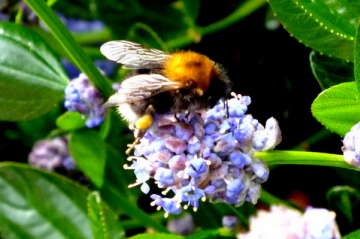 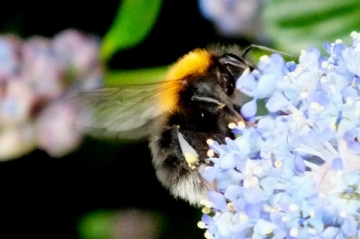 They are extremely active compared to the lumbering White and Red-tails, scurrying around on the flower heads at a terrific pace making photography nigh-on impossible, plenty of flower heads with not a bee in sight or just blurred images. They are also aggressively inquisitive coming right up to the camera and face, buzzing in quite an intimidating manner, whereas the Whites and Reds continue about their business and take no notice. Also noted are Common Carders, Buff-Tails, and one that I cannot identify having a fluffy grey thorax with a black and grey striped abdomen. Honey bees are very scarce with only the odd one or two in our shrubs and flowers. This may be, in some part, due to our neighbours who recently had a chimney removed, one less for the Jackdaws to build in. Before they started work saw what seemed to be white smoke issuing from the roof tiles around the chimney. Fearing a fire I got the bino’s out to investigate, only to see a swarm of bees on the tiles and realised what was happening. Soon after several bees arrived in the garden with white powder on them and died. The chimney was removed soon after. A recent search of the Mistley Walls/Mistley Place Park area for ladybirds was absolutely fruitless. All that we found were three, 14-Spots in the reeds along the river. Given the thousands there had been the winter before last it was quite a disappointing result. Pine ladybirds were not seen, but here again the trees in which they are normally found are devoid of scale insects which appeared to be their attraction to the area. We did however find three Nettle Taps on a nettle bed near Mistley Towers. 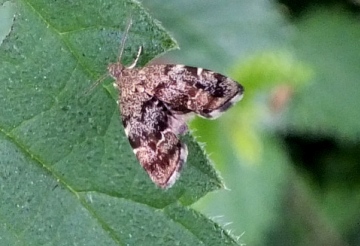 Looking at the NBN map it does show this moth as present along the Stour valley but not very prevalent in north Essex. Is this a comparatively uncommon moth or is it just a lack of records? Wed 12th June 2013 16:32 by Graham Smith Tree Bumblebees
Tree Bumblebees are nesting in my garden this year. Unusually, they have chosen a site only a foot or so off the ground in a green bin used for grass clippings. The plastic has cracked on the edge of the door, creating a small hole, by which they gain access. I could have sworn Bombus hortorum was nesting there early in the spring but it is clearly hypnorum that occupies the nest now. Perhaps I need to go to the opticians or maybe the queen Tree Bumblebee usurped the original owner, although I can find no information about this having been recorded. They are truculent little things though! This morning I noticed about a dozen 'swarming' at the entrance of the nest, dancing the dance of a thousand veils! They were larger than the workers and according to Clive Hill on the Bumblebee Conservation website were probably drones from elsewhere laying in wait for virgin queens emerging from my nest. Unlike other bumblebees in the garden they are particularly susceptible to the UV light emitted by my moth trap and I found no less than eight there this morning. Fortunately, they are dopey after their night's sojourn but soon recover when I place they on strawberry flowers nearby. These, along with the blooms of Loganberry, appear to be their favourite forage plants in the garden. At least when they are sleepy it is possible to get a photo; at other times they quickly get agitated if you disturb them, even when they are only foraging.
I also have another bumblebee's nest in the garden. The shed door doesn't shut properly, leaving a gap, and a queen Bombus pratorum found her way in there and decided to nest behind a draw in one of the cabinets. Apparently they often choose odd nest sites like this and have even been recorded nesting in the pocket of a coat hanging on a peg! They are much more placid than hypnorum and go about their business quite happily while the shed is occupied. There is probably also a nest of the Common Carder Bee Bombus pascuorum nearby as workers are constantly to be seen gathering pollen from Water Avens, a favourite foraging plant of theirs. Unlike last year, though, there has been little sign of either Bombus lucorum or B terrestris in the garden this summer and only a few B. lapidarius. The 5th June was warm and sunny (I treasure the memory!) and while at Blue House saw the first queen Shrill Carder Bee B. sylvarum of the year on the wing. That day was the first occasion this season when it really felt like summer was on the way. Good numbers of both Small Heath (27) and Common Blue (15) were on the wing, the latter total being more than I saw on any one day last year. There was also a mass emergence of Odonata and a short walk along the farm's ditches produced 17 Hairy Hawkers and a few Four-spotted and Broad-bodied Chasers along with dozens of damselflies. This photo of an Azure Bluet was taken by fellow volunteer John Lilley, who has allowed me to use it here. It is perhaps not quite fully mature as the stripes on the thorax are still white, rather than blue. Since then though the cool and cloudy weather has returned and insects are at a premium once more. Colin Plant, writing recently with regards to the Hertfordshire Moth Group, was bemoaning the lack of moths in that county. It is no better in Essex it would seem. June is one of the peak months yet I am lucky to catch 7-10 a night compared with the 60-70 that could normally be expected. Admittedly I use a 60WUV trap, and there is a lot of competition in the area from street lamps and security lights, but at Blue House, where it is much darker, I use a 120WMV but last Tuesday I caught just a single moth, a Flame Shoulder! This fine Pale Tussock was one of the few species to turn up recently. Micro moths seem to be in even shorter supply than macros and are all but non-existent. If the season is going to 'catch up' as everyone seems to be hoping it has got to get a move on. Looking out of the living room window at the wind bending the trees and the rain slanting against the panes, there is not much sign of that happening yet! Wed 5th June 2013 09:39 by Peter Harvey
Dear Peter
The cuckoo bee foraging on the Oxford ragwort is indeed Nomada goodeniana, a widespread species at this time of year. It is one of the few Nomada which can be reasonably confidently identified from a photograph. From the darkened segments on the antennae, yours was a male. It will also have a characteristic pad of short hairs on the underside of the base of the hind femora, but this will only be visible under a microscope. Tue 4th June 2013 16:40 by Peter Pearson
On one of those odd sunny days during the winter my wife and I walked the sea wall from Clacton Martello to Jaywick. A near gale S.E., wind was blowing across the dunes whipping up the sand leaving us feeling as though we were being sand blasted. All along the route there were piles of dried Sea Holly stems that had been snapped off by the wind and collected under the lee of the wall.
Having seen Sea Holly at Walton and Harwich where a few plants can be found I was interested to know the extent of the coverage of the dunes here and again visited the area on 02/06/2013. There was plenty of new growth appearing and the coverage of the dunes was very extensive. It is not known if this is natural seeding or there has been planting to assist stabilising the sand. The below photograph is of a small area adjacent to Clacton golf course TM162134. 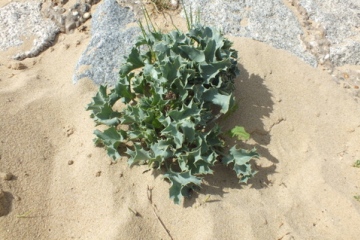 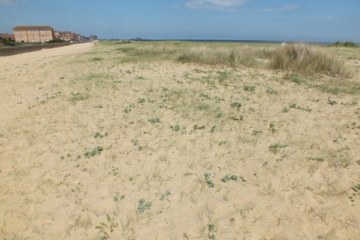 While searching the area, one clump, of what I think is Oxford Ragwort (Senecio squalidus) was discovered and photographed. 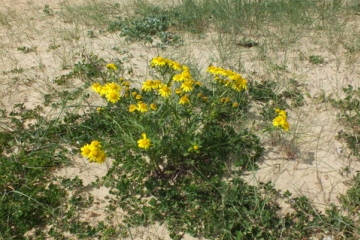 As I was taking the photo I noticed the below insect feeding on one of the flowers. 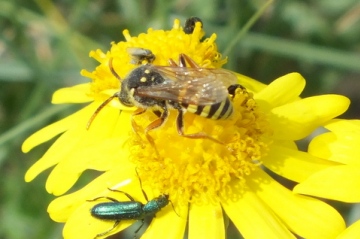 Although it looked very much like a wasp, researching the web I believe it to be a Gooden's Nomad Bee (Nomada goodeniana). The EFC species account for this bee doesn’t seem have many recent records in the area, and if this is indeed what the insect is, I thought it may be of interest. |
Archives: May 2020Aug 2019 Jan 2019 Sep 2018 Jul 2016 Oct 2015 Jul 2015 May 2015 Apr 2015 Mar 2015 Feb 2015 Jan 2015 Dec 2014 Oct 2014 Sep 2014 Aug 2014 Jul 2014 May 2014 Apr 2014 Mar 2014 Feb 2014 Jan 2014 Dec 2013 Nov 2013 Sep 2013 Aug 2013 Jul 2013 Jun 2013 May 2013 Apr 2013 Mar 2013 Feb 2013 Jan 2013 Dec 2012 Nov 2012 Oct 2012 Sep 2012 Aug 2012 Jul 2012 Jun 2012 May 2012 Apr 2012 Mar 2012 Feb 2012 Jan 2012 Dec 2011 Nov 2011 Oct 2011 Sep 2011 Aug 2011 Jul 2011 Jun 2011 May 2011 Apr 2011 Mar 2011 Feb 2011 Jan 2011 Dec 2010 Nov 2010 Oct 2010 Sep 2010 Aug 2010 Jul 2010 Jun 2010 May 2010 Apr 2010 Mar 2010 Feb 2010 Nov 2009 Oct 2009 Aug 2009 Jul 2009 Jun 2009 May 2009 Apr 2009 Mar 2009 Feb 2009 Jan 2009 Nov 2008 Oct 2008 Sep 2008 Aug 2008 Jul 2008 Jun 2008 May 2008 Apr 2008 Mar 2008 Feb 2008 Jan 2008 Dec 2007 Nov 2007 current posts |


















